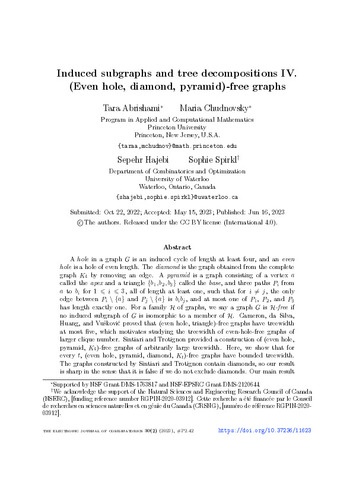| dc.contributor.author | Abrishami, Tara | |
| dc.contributor.author | Chudnovsky, Maria | |
| dc.contributor.author | Hajebi, Sepehr | |
| dc.contributor.author | Spirkl, Sophie | |
| dc.date.accessioned | 2023-10-20 17:36:29 (GMT) | |
| dc.date.available | 2023-10-20 17:36:29 (GMT) | |
| dc.date.issued | 2023-06-16 | |
| dc.identifier.uri | https://doi.org/10.37236/11623 | |
| dc.identifier.uri | http://hdl.handle.net/10012/20052 | |
| dc.description | This work is published in the Electronic Journal of Combinatorics, available here: https://doi.org/10.37236/11623 ©The authors. Released under the CC
BY license (International 4.0) https://creativecommons.org/licenses/by/4.0/ | en |
| dc.description.abstract | A hole in a graph G is an induced cycle of length at least four, and an even hole is a hole of even length. The diamond is the graph obtained from the complete graph K4 by removing an edge. A pyramid is a graph consisting of a vertex a called the apex and a triangle {b1, b2, b3} called the base, and three paths Pi from a to bi for 1<i<3 all of length at least one, such that for i=/ j the only edge between Pi\{a} and Pj\{a} is bibj, and at most one of P1, P2, and P3 has length exactly one. For a family H of graphs, we say a graph G is H-free if no induced subgraph G is isomorphic to a member of H. Cameron, da Silva, Huang, and Vuskovic proved that (even hole, triangle)-free graphs have treewidth at most five, which motivates studying the treewidth of even-hole-free graphs of larger clique number. Sintiari and Trotignon provided a construction of (even hole, pyramid, K4)-free graphs of arbitrarily large treewidth. Here, we show that for every t (even hole, pyramid, diamond, Kt)-free graphs have bounded treewidth. The graphs constructed by Sintiari and Trotignon contain diamonds, so our result is sharps in the sense that it is false if we do not exclude diamonds. Our main result is in fact more general, that treewidth is bounded in graphs excluding certain wheels and three-path-configurations, diamonds, and a fixed complete graph. The proof uses "non-crossing decompositions" methods similar to those in previous papers in this series. In previous papers, however, bounded degree was a necessary condition to prove bounded treewidth. The result of this paper is the first to use the method of "non-crossing decompositions" to prove bounded treewidth in a graph class of unbounded maximum degree. | en |
| dc.description.sponsorship | NSF Grant, DMS-1763817 || NSF-EPSRC Grant, DMS-2120644 || Natural Sciences and Engineering Research Council of Canada (NSERC), RGPIN-2020-03912. | en |
| dc.language.iso | en | en |
| dc.publisher | Electronic Journal of Combinatorics | en |
| dc.relation.ispartofseries | Electronic Journal of Combinatorics;30(2) | |
| dc.rights | Attribution 4.0 International | * |
| dc.rights.uri | http://creativecommons.org/licenses/by/4.0/ | * |
| dc.title | Induced Subgraphs and Tree Decompositions IV. (Even Hole, Diamond, Pyramid)-Free Graphs | en |
| dc.type | Article | en |
| dcterms.bibliographicCitation | Abrishami, T., Chudnovsky, M., Hajebi, S., & Spirkl, S. (2023). Induced subgraphs and tree decompositions IV. (even hole, Diamond, pyramid)-free graphs. The Electronic Journal of Combinatorics, 30(2). https://doi.org/10.37236/11623 | en |
| uws.contributor.affiliation1 | Faculty of Mathematics | en |
| uws.contributor.affiliation2 | Combinatorics and Optimization | en |
| uws.typeOfResource | Text | en |
| uws.peerReviewStatus | Reviewed | en |
| uws.scholarLevel | Faculty | en |


